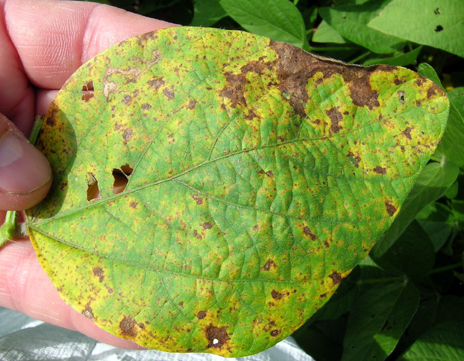Researchers among those honored for soybean rust work
Researchers among those honored for soybean rust work

When soybean rust was discovered in Paraguay in 2001 and in Brazil in 2002, researchers in the United States began preparing for the first appearance of the disease, which has the potential to totally decimate an entire crop.
“There was a lot of fear among growers, industry and researchers,” said Don Hershman, extension plant pathologist with the University of Kentucky College of Agriculture.
Hershman was one of several U.S. plant pathologists who formed a committee to proactively work on identifying and researching soybean rust to make sure its impact on the U.S. crop was as minimal as possible.
That group evolved to be called the NCERA-208 and involved scientists from more than 30 land-grant universities, federal agencies and industry associations. It recently received the 2012 Experiment Station Section Award of Excellence in Multistate Research from the National Institute of Food and Agriculture and the Association of Public and Land-grant Universities at the Annual APLU Awards Program in Denver.
The team of scientists, which in addition to Hershman includes UK grain crops specialist Chad Lee, worked closely with the Soybean Rust component of IPM PIPE, the Integrated Pest Management Pest Information Platform for Extension and Education. The groups set up sentinel plots across the U.S. to monitor the disease, develop educational materials, test and register fungicides and conduct research on disease-resistant varieties. Hershman served as co-director of the Soybean Rust IPM PIPE and as a liaison between the group and the NCERA-208 from 2005 to 2010.
“Being a part of these groups has helped me present the best possible information to our stakeholders,” Hershman said.
The groups’ efforts have diminished apprehension in the United States and abroad about the disease. As soybean rust has yet to severely impact the United States, the monitoring system has kept fungicide use at a minimum, which has saved producers millions of dollars and reduced the risks to human health and the environment.
“There’s a whole different mentality from 2005 to now,” Hershman said. “A lot of people who would have sprayed fungicides then aren’t applying them now for soybean rust control.”
The groups are active today, though most of the sentinel plots are in southern states, as the disease tends to overwinter on kudzu in Gulf Coast states and Mexico. These plots are funded by checkoff dollars from the United Soybean Board. Hershman still maintains five sentinel plots in Kentucky, and those are funded by the Kentucky Soybean Promotion Board.
Awards Extension Research


